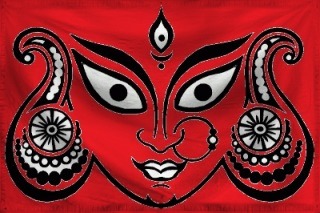6
The Matriarchy of Shaktirajya - Religion
Shakta DharmaThe Matriarchy of Shaktirajya is a confederation populated by Goddess-worshipers from around the world. The official religion of Shaktirajya is Shakta Dharma or the goddess worshiping sect of Hinduism. In accordance with Hindu orthopraxy, Brahmins are the priestly caste, though their role is largely ceremonial. All citizens of Shaktirajya, male and female, are permitted, nay expected, to study the Vedas, the oldest Hindu holy books. While Brahmins are the traditional priestly caste, anyone with the requisite knowledge of performance of rites and a high degree of esteem within the Gemeinschaft (German. "Community") may perform priestly duties i.e. act as Pujaris or ritual-officers. The Brahmins are traditionally offered gifts of land and goods in return for their services, or as an act of goodwill or statement of faith on behalf of pious devotees in accord with Hindu custom. While 'Hinduism' is the "Great Tradition" of Shaktirajya, there are various smaller "little traditions" of goddess and nature-spirit cults with their own unique rites, customs, and beliefs. Shaktirajya is a multi-ethnic Confederation populated by Bengalis, Punjabis, Tamils, Malayalis, Kashmiris, Germans, British, Irish, Greeks, Italians, Sicilians, Norse, Kurds, Americans, Balinese, Javanese, and others. Each ethnic group brings their own rites into the greater milieu of Shaktirajya. Over time, there has even been a considerable blending of beliefs and customs into a composite tradition. Each ethnic group is assigned its own caste (Sanskrit. Varna). For example, Greeks and certain other Europeans are known as Yavanas (Sanskrit. "Ionian or Greek speaking foreigner"). The Yavani or Greek females are common stock-characters in Sanskrit literature where they appear as a king's palace guards. While caste serves as a marker of identity, caste as a tool of hierarchical domination has been completely abolished and mixed-caste marriages are common. The ancient pre-Christian and pre-Islamic deities of the above-mentioned ethnic groups are worshiped alongside their Hindu counterparts and their respective pantheons and cults have all been peaceably 'Hinduized' to an extent.
The highest spiritual authority in the land is the Maharani ("Queen") called the Rajarajeshwari ("the Divine Empress of Empresses") Hypatia Sophia I seen as the Vicar of the Goddess on Earth. Like the Brahmins, Her role is largely ceremonial and serves as a focus for the spiritual-libidinous energies of the People.
-Minority Religious Currents
Normative Abrahamic religion (i.e. Judaism, Christianity, and Islam) is greatly frowned upon in Shaktirajya due to its historical track record of persecuting people who worship other gods, and their inability to respect the so-called "pagan" religions of their host countries and neighbors. Indeed, the practicing of exclusive intolerant monotheism is completely outlawed and forbidden. Though the normative manifestations of these religions are outlawed, historically heterodox and heretical currents of these religions are tolerated and allowed to exist. Non-normative heterodox and heretical currents within Abrahamic religions include Gnosticism, Kabala, Sufism, Ismailism etc. Everyone regardless of religious affiliation must sprinkle some incense on the High Altar of the Panchayat as a gesture of allegiance and good-will.
There are also sizable communities of Buddhists, Taoists, Shinto followers etc. Atheism and agnosticism are acceptable philosophical and theological positions as long as members of these communities respect the official religion and customs of the land. It is not uncommon for citizens who identify as Atheist or agnostic to be well-versed in ancient holy books, and to perform their ancestral rites.











